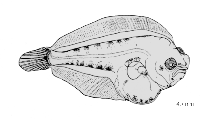| FishBase |
Larvae Information Summary for
Solea ovata

| Main Ref: | Thangaraja, M. and K. Ramamoorthi 1982 | |||
Yolk-sac larvae
| max | min | mod | Ref. | |
| Length at birth (mm) | 1.84 | 40975 | ||
| Preanal L. % TL |
| Place of development | planktonic | |||
| Larval area | Vellar Estuary, India | |||
| Yolk-sac | ovoid pigmented | Ref: | 40975 | |
| Yolk | unsegmented | Oil globules | more than one oil globuleposterior | |
| Rows on tail | no rows | |||
| Other melanophores on tail | more than two dorso-ventral clusters or bands | |||
| Melanophores on head + trunk | melanophores on head + trunk | |||
| At 1.84 mm, oil globules aggregate on ventral section of the larva and posterior part of yolk sac. Anus opens at a distance of 0.06 mm from the posterior end of yolk sac. Pulsating heart and auditory vesicle prominent. There are 37 myotomes (12 preanal and 25 postanal). Pigmentation: Yellow punctate pigments seen from the snout to the caudal, including the surface of eyes. Groups of punctate pigments present on the larval finfold, around anus and on either side of caudal. There are prominent stellate pigments all over the yolk sac. At 2.71 mm, yolk sac reduced. Oil globules clustered together at about the middle of yolk sac. Pectoral fins begin to appear. A very prominent hood-like projection develops over crest of the head. Eyes are unpigmented and mouth still not open. Tubular heart and auditory vesicles prominent. Pigmentation: Generally, the larval is dark yellow in colour, with yellow pigments all over the body except the fin fold. Prominent stellate pigments on the yolk sac present at the previous stage have disappeared. Three bands of chromatophores discernible - on anal, caudal, and in between the anal and caudal regions. Striations of caudal rays not yet discernible. | ||||
Post larvae
| Striking feature | lower jaw strongly projecting | |||
| Striking shape lateral | normal (not striking) | dorsal | normal (not striking) | |
| Striking feature | lower jaw strongly projecting | |||
| Shape of gut | elongated | |||
| Gas bladder early | late | |||
| Spinal armature early | no spines | late | no spines | |
| Pigmentation early | ||||
| Rows on tail | no rows | |||
| Other melanophores on tail | one dorso-ventral cluster or band | |||
| Melanophores on head + trunk | melanophores on head + trunk | |||
| Pigmentation late | ||||
| Rows on tail | no rows | |||
| Other melanophores on tail | one dorso-ventral cluster or band | |||
| Melanophores on head + trunk | melanophores on head + trunk | |||
| Urostyle region early | pigmented | late | unpigmented | |
| Peritoneum | with row of melanophores | |||
| Pectorals | normal | |||
| Pelvics | normal (i.e. small or absent) | |||
| At 2.9mm, colour of body is yellow. Yolk and oil globules are completely absorbed and the mouth is open with well developed jaws. Lower jaw is larger then upper jaw. Eyes are pigmented. There are 2 prominent stellate chromatophores on the anal region in the place of a single chromatophore of the previous stage. A few new punctate pigments appeared at the tip of the caudal finfold. Operculum is well developed. Myotomes are not visible outside as a result of dense pigmentation. At 3.325 mm, eyes and jaws are movable. Tubular heart is modified into a sac-like structure. Striations of caudal rays have appeared. Larva is reddish yellow in colour from snout to anus. The anal band has reappeared. The fiber-like brown pigment bands have prominent punctate chromatophores. A new pigment has appeared just behind the hood-like structure. At 2.825, (total length was reduced), pale brown punctate chromatophores are on 3 reticulate blackish brown pigment bands on the ventrolateral aspects of abdomen. The rest of the body is reddish yellow in colour. After several hours, the reticulate blackish brown pigment on the abdomen, lower jaw and hood have changed into black chromatophores. Stellate black chromatophores are present on the middle and caudal regions of the body. A few pink chromatophores have appeared on the ventrolateral aspect of the abdomen and the cephalic region. At 3.0 mm, reticulate pigments on the abdomen are localized at the ventrolateral aspect and also on the upper part, near the pectoral. There are scattered stellate chromatophores on the head and the pigment bands. Caudal rays have increased in number. At 3.8 mm, body is much deeper and stellate black pigments are on the hood, around the eyes, on the operculum and on the abdomen. The pigmentation on the abdomen is much intensified. The middle band of chromatophores contains thick stellate pigments, the caudal band now has only a single stellate pigment, while the anal band shows only few stellate pigments. Minute fin rays have appeared in the larval fin fold. | ||||
| L 1st feeding | Ref. | Months of presence of larvae | ||||
| max | Jan | Feb | Mar | Apr | ||
| min | 2.9 | 40975 | May | Jun | Jul | Aug |
| mod | Sep | Oct | Nov | Dec | ||
| Water parameters Metric characters |
| Back to Search |